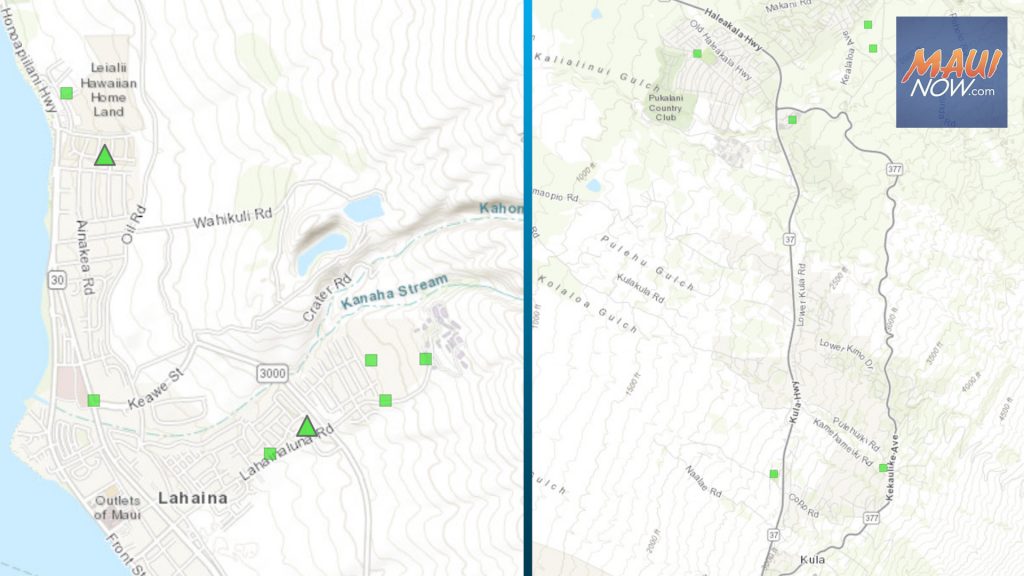Health Dept. reports that preliminary Maui air monitoring shows good air quality
Results from preliminary air sampling and air monitoring conducted in Lahaina and Upcountry Maui are reassuring, according to the state Department of Health. “The results do not show evidence of poor air quality or any hazardous levels of contaminants in the air at the time the samples were collected,” the department reports.
The Hawaiʻi Department of Health collaborated with the US Environmental Protection Agency to analyze preliminary, unvalidated data from baseline air monitoring.
State Health Director Dr. Kenneth S. Fink said “It’s critical to remember that air monitoring is indicative of the ambient air quality, and high winds or cleanup activities could cause dust and ash to become airborne. We continue to urge Maui residents to wear a high-quality mask, such as an N95 mask, and other personal protective equipment when in impacted areas. Precautions should also continue to be taken in nearby areas should the air quality change due to disturbed ash from an impacted area.”
In addition to the baseline air sampling conducted, EPA and DOH installed 13 real-time PM2.5 sensors in Lahaina and Upcountry Maui following the wildfires. These monitors scan for a very fine, dust-like material called “Particulate Matter” or PM 2.5, which is indicative of ash and dust.
Contaminants of concern, such as metals like lead or arsenic, stick to the pieces of ash and dust that register as particulate matter. Because of this, air monitoring for PM2.5 can be used as an indicator for contaminant monitoring. If PM2.5 measurements are not above typical baseline levels (remain in the green zone), then ash and dust from the impacted areas, with their associated contaminants, are not in the air in any measurable amount that would be considered harmful.

As contaminants are present in dust and ash, proper precautions should be taken when in the impacted area to avoid exposure. This is also important in instances where the ash and dust may be disturbed such as in high winds, when sifting through ash, during clean-up or when heavy machinery is used to remove debris.
To view the preliminary, unvalidated data, click on the links below:
- https://health.hawaii.gov/mauiwildfires/files/2023/09/Maui-Air-Preliminary-Data-1.png
- https://health.hawaii.gov/mauiwildfires/files/2023/09/Maui-Air-Preliminary-Data-2.png
It is important to note that the data available have not yet been validated. This means the currently available data is preliminary and hasn’t been double checked by the lab or quality tested by an independent third party. The final results may be different, and data is expected to be added. That validation process is ongoing, and the validated results will be shared as soon as they are available. The validation process may take several weeks.
Testing Methodology:
The baseline testing was completed using specialized air monitors and air sampling. Air monitoring consists of using a AreaRae Pro Portable Monitor to measure contaminants. Air sampling involves collection of air for laboratory analysis using Summa Cannisters.
The purpose of air sampling is to measure how much of a specific contaminant is present in the air over a period of time. For this response, samples were collected over time periods ranging from 12 to 24 hours and were submitted to a laboratory for analysis. Laboratory analysis for different contaminants is done with different methods and some contaminants take longer to show results than others.
The preliminary data includes results of tests for the following contaminants:
PM2.5 is very small particulate matter that can be a component of ash, dust, smoke and air pollution. Short-term exposure to PM2.5 can cause irritation of the eyes, throat, and lungs. Longer term exposure to PM2.5 can lead to worsening of chronic respiratory diseases like asthma and COPD as well as heart attacks and other significant health problems. PM2.5 was detected at low levels in the preliminary data and is consistent with what is expected for this region of Maui under regular conditions.
Lead is a heavy metal that is expected to be present in ash due its use in paint on houses built before 1978. Lead is particularly toxic for young children and babies in utero as it hinders the development of the brain. Babies and children exposed to lead have trouble with learning, school performance, attention, and other neurocognitive problems. No lead was detected in the preliminary air monitoring data.
Arsenic is a heavy metal found in soils in Hawaii due to its use as an herbicide in the early 1900s. It is also found in building materials made of sugar cane (Canec). Long-term, environmental exposure to arsenic can cause skin problems, heart problems and cancers of the skin, bladder and lungs. No arsenic was detected in the preliminary air monitoring data.
Asbestos is a naturally occurring mineral used in building materials because of its fire-resistant properties. Long-term exposure to asbestos is associated with skin cancers. Asbestos is especially toxic in people who smoke. No asbestos was detected in the preliminary air monitoring data.
Benzene is a hydrocarbon compound present in wildfire smoke, cigarette smoke, motor vehicle exhaust, volcanic emissions, glues and solvents, and industrial emissions. Long-term exposure to benzene can impact the bone marrow causing anemia and leukemia. Benzene results are still pending from air samples sent to the laboratory.
VOC stands for Volatile Organic Compounds which is a class of chemicals that evaporate easily and are found in many household products such as paints, varnishes and cleaning products. The currently available, preliminary monitoring tested for VOCs in total using air monitors. The EPA uses a screening level of 500 parts per billion (ppb) for total VOCs. So far, the unvalidated air monitoring data shows total VOCs to be below the initial screening level. Air samples for specific VOCs, including Benzene, were taken and are currently being analyzed by the laboratory.







